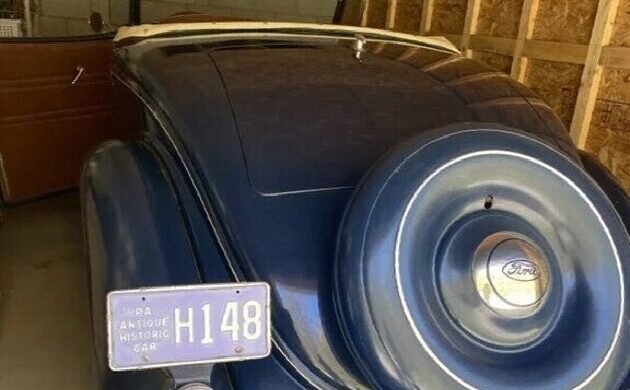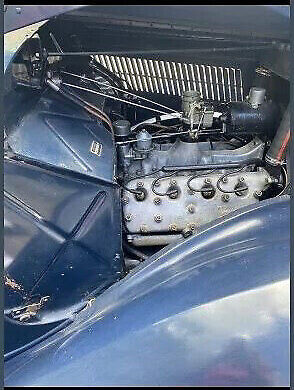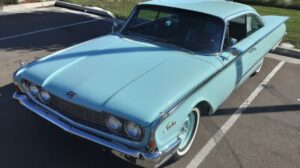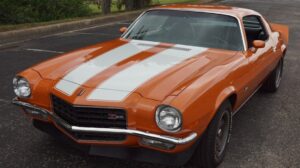By the late 1920s, Edsel Ford finally convinced his father that the best-selling Model T needed an evolution. When the 1930s rolled around, that evolution became a revolution. Now in keen competition with Chevrolet, Ford began updating its models annually, stoking enthusiasm as the world struggled in the mire of the Great Depression. Ford sold 820,000 cars during 1935, stealing the sales crown – thanks to a modernization of the Model 40. The new car was called the Model 48; by 1936, with a minor facelift, it became the Model 68. Designers had been integrating fenders into bodies for some time, but in 1935, that integration took a leap forward. The grille, too, was straight out of Art Deco 101, wrapped beautifully around the car’s nose. Here on eBay is an example of the rarest of Model 68s – a rumble seat roadster. Bid to $30,600, reserve not met, this Ford is located in Bridgeville, Pennsylvania. It runs and drives well, with regular maintenance on a restoration performed back in 1969.
By 1936, Ford’s 221 cu. in. flathead V8 was putting out 85 hp, and the car could reach about 85 mph with a tailwind. This car has a four-speed manual transmission that the listing notes as rebuilt; original equipment would have been a three-speed. The front and rear shocks as well as the mechanical brakes were rebuilt, too, in 2020. Ford had moved the front springs forward of the axle by the time the Model 68 was produced, increasing the cabin space by several inches. The car comes with its owner’s manual, V8 instruction manual, and other literature.
The banjo steering wheel, rearview mirror with clock inset, and two side-view mirrors all show well. By now the trip odometer offered four digits; the seller assures us that all the gauges function. The side curtains are with the car. All the chrome was renewed during the 1969 restoration, though the photos are too hazy to judge how it looks now. The dash could use polishing.
Ford made fewer than 4000 roadsters in 1936. The roadster is defined by its windshield frame, which is not incorporated into the body and acts as the anchor for the top. The Club Cabriolet is very similar but note the windshield fitment, into a frame that forms the front cowl. This Washington Blue car is said to have zero rust, minimal filler, and a powder-coated frame. It needs a few hours of elbow grease to really make the chrome and paint pop, but as it is, I think it’s underbid. Nice drop-top Model 68s can sell for $35k to $40k, and this roadster is a rare bird. I think it should sell closer to $35k – what do you think?














Probably a great looking car but with nothing but parts pictures we’ll never know.
Agreed bobhess. A car with gorgeous lines and not a single full side shot.
All I can say is, hopefully it doesn’t get butchered and bastardized
i wish people would learn how to take a proper car picture
Nobody knows how to use a camera any more (or even owns a real one), let alone knowing how to take actual photographs.
Just use your cheapa$$ cell phone. Looking at these pix, it seems the ‘photographer’ doesn’t know you can turn the phone sideways to get landscape format pix.
Everyone you send it to will look at it on a phone also so they don’t know how bad it sucks.
The ‘36 ROADSTER was a watershed year whereby FORM passes FUNCTION.
The manner in which the top of the door sill is rolled over sans window opening and flows over and upward to meet the edge of the curved dash board is a subtle thing of beauty. The way a sculpted accent line starts at the tip of the hood and scrolls back across the neckline of the door and body on down and under the spare tire on up and heads forward to the tip of the hood line is magnificent. The subtle cathedral arched front fenders enhances what is just a basic curved fender. The bullet shaped headlight housing with curved lenses project an Art Deco influence. The flat side surfaces of the front fender following the curve of the tire line and flow back to meet the running board skirt line give it a more robust look. The extended rear surface is reminiscent to that of the Lincoln Zephyr.
It is just such a beautiful automobile.
By golly, who needs photography after that wonderful treatise?
Silver Fox, indeed!
Wasn’t this model (68) one of Fords last Roadsters? Or the last?
I see a door handle but not sure if its a window roller> Does this have door windows? (Hope this is NOT redundant?)Did true Roadsters have windows?
I agree with Silver Fox on the subtleties and Deco lines. This is an elegant little Roadster. A special pre-war FORD. I have a 41Pick Up and 38 Deluxe Coupe(tight little car). I never get tired of the lines on these cars!
I have enough cars at my age but I have always loved these Roadsters.
1937 was the last Ford roadster. Roadsters and phaetons had side curtains instead of side windows.
Thank you for the edification. I appreciate it. It was a few loose facts rattling around in my head that you sorted for me.
Regg